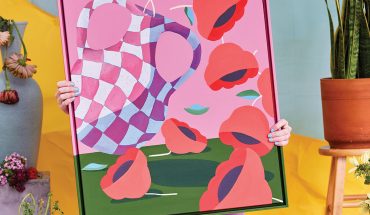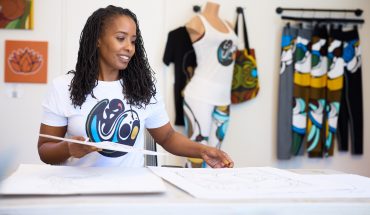Paperhand Puppet Intervention combines art and activism with their inventive performances and hand-made creations.
By Colony Little | photography by S.P. Murray
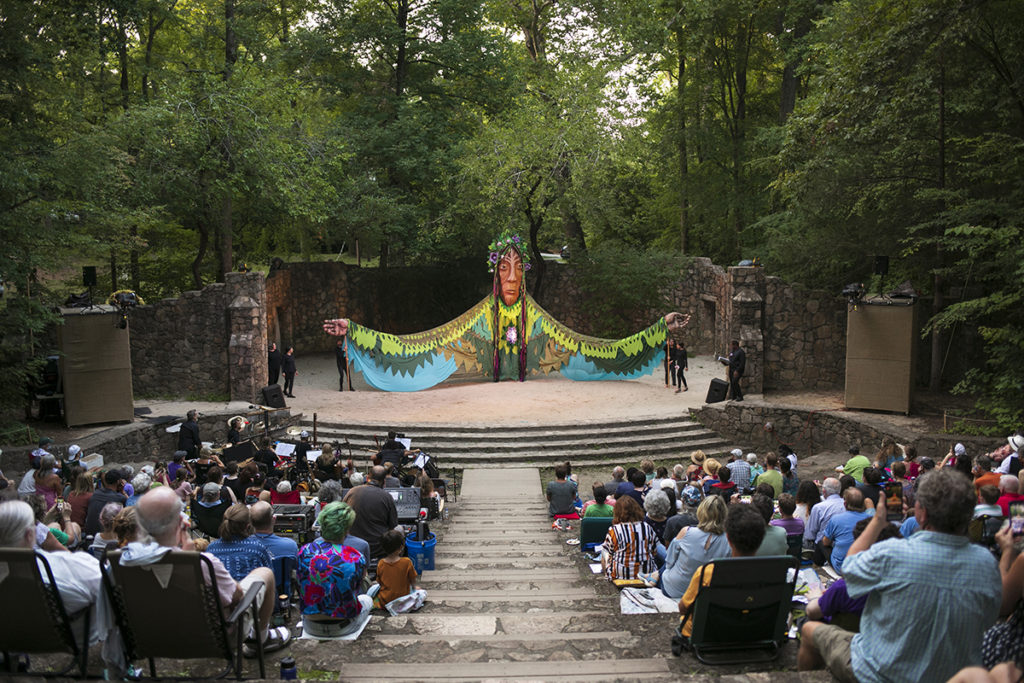
They appear out of the shadows at dusk, emerging from trees and cobblestone walls. There’s a colossal face with exaggerated features and deeply lined wrinkles. Eyes peer from behind a wall of brilliant leaves. A bird of many colors descends, billowing a trail of silk. These figures are both familiar and foreign, materializing from an enchanted world to briefly inhabit ours.
They are all puppets, fantastical creatures that are part of the Paperhand Puppet Intervention. The brainchild of founders and directors Donovan Zimmerman and Jan Burger, Paperhand produces performances that combine multiple forms of puppetry — including rod and hand puppets, shadow puppets and stilt dancing — with live music, poetry and dance. And the display is part of their annual summer performance at the cavernous, open-air Forest Theatre at the University of North Carolina at Chapel Hill. Here, these larger-than-life masked creatures have invited audiences into a world of wonder for 22 seasons.
“Puppetry gives this palpable suspension of disbelief,” says Donovan. “I’ll bring a puppet into the audience and I’ll see them with their arms stretched out, and I see them wanting to connect in that moment.”
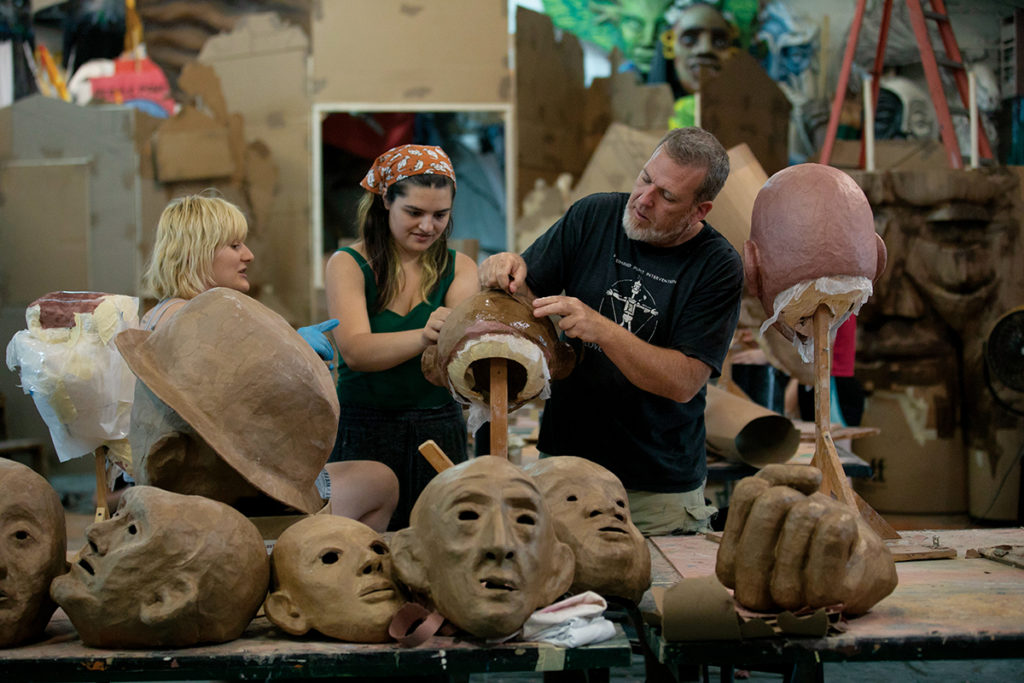
Zimmerman and Burger met while working the Haw River Festival and Learning Celebration in 1998 and formed Paperhand one year later. Inspired by the Vermont-based troupe Bread and Puppet, which combines puppeteering with political theater, Paperhand creates work meant to inspire and promote social change around issues like environmental preservation, consumerism and overdevelopment. “We want to touch people’s hearts,” says Burger. “We start with ancient stories but look at what’s happening in the work and change them to speak to people in a way that’s accessible and not just information.” Paperhand produces an annual summer pageant that they perform August through September at the Forest Theatre and the North Carolina Museum of Art, then spend the rest of the year performing at parades, special events, protests and through collaborations with other cultural groups, like the North Carolina Symphony.
Paperhand’s biggest time for creation is the summer. Each year, Zimmerman and Burger choose a different story to explore, like 1998’s The Water of Life, 1999’s The Old Cow Who Saved the River or 2013’s Invisible Earth, which used old parables to offer a call to help the environment, or 2006’s As the Crow Flies, which incorporated American folk parables from to address social justice.
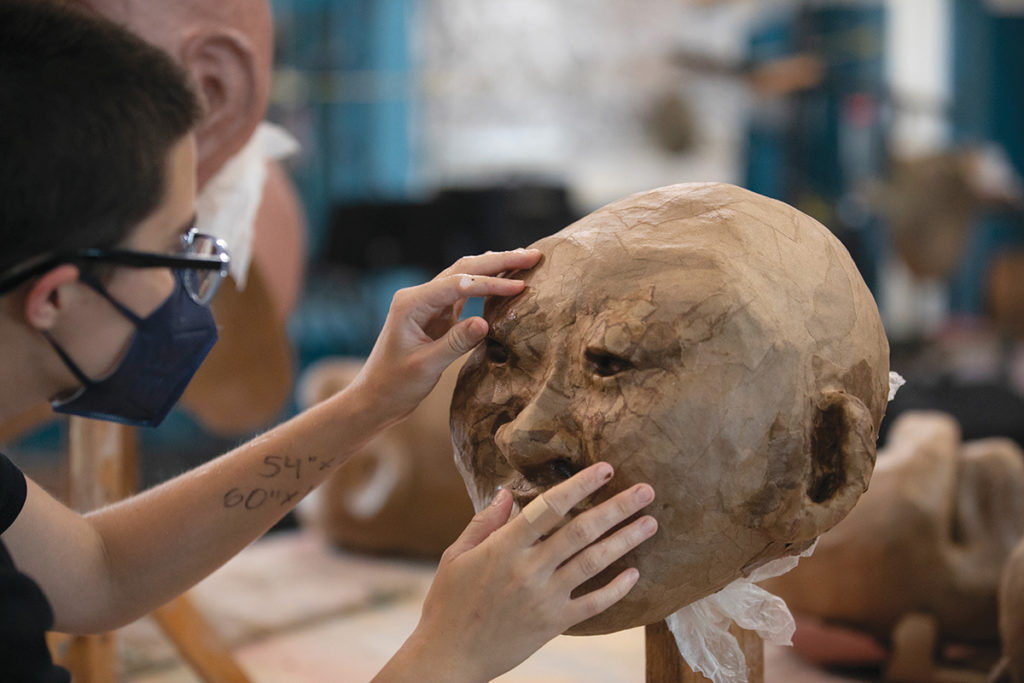
Then, along with some dozen artists, interns and volunteers, they spend months in their Saxapahaw workspace creating the performance: outlining plots, sketching puppets, sewing fabric, writing lyrics and humming melodies. “It’s not the nicest time to be in the studio,” laughs Burger. “It’s ridiculously hot, we’re all sitting in front of fans.”
Piece by piece, the show comes together, each element building on the other. “The show is not written when we start making the puppets, but we generally know where we’re going,” says Burger. As the puppets are made and the puppeteers start to move them, the musicians get inspiration, and vice versa: movement and storylines are inspired as the melodies develop. “The musicians create their own universe; all we can do is give them inspiration,” says Burger. “I’ll say, this part should be energetic or sad, or I’ll feed them words and they’ll come back with a rhyming scheme. Sometimes one sentence will inform an entire piece that blows us away.”
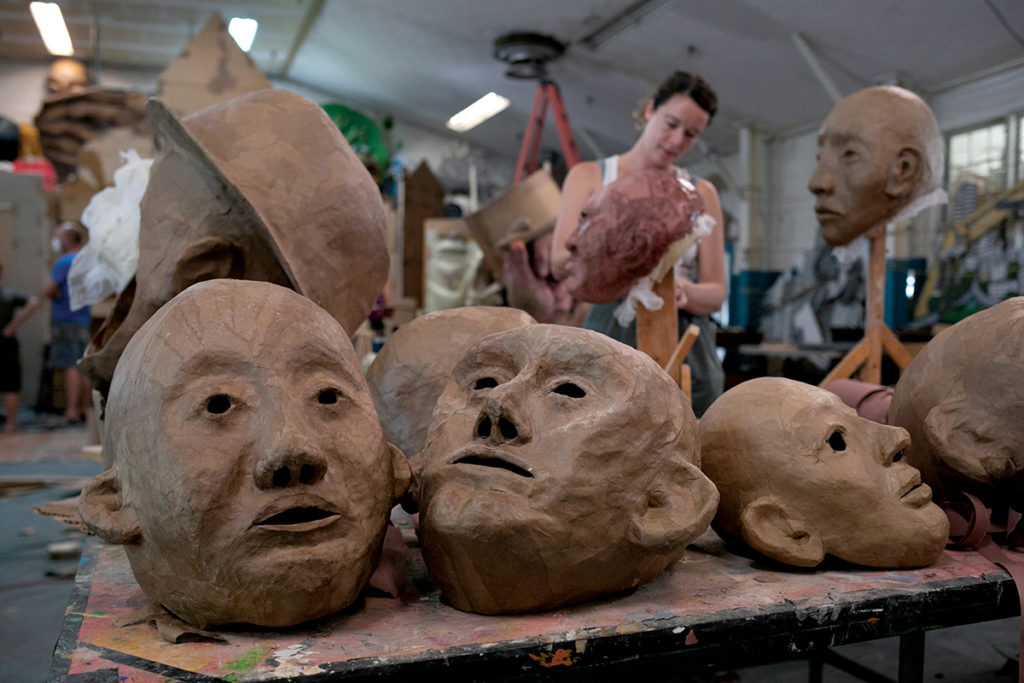
But the huge puppets, with their overscale faces and dramatic features, are what the studio is best known for. These are mostly made of paper mâché and cardboard, through techniques they’ve perfected over decades. A puppet head mold is assembled on a post made from a two-by-four nailed to a platform, often starts with a found objects (like an old paint can) as the base. The crafters cover the base with thick plastic bags from a brewery down the road, then wrap everything tightly with tape. Then they start to add features using balled-up newspaper, tape or thin cardboard stapled in place.
“Once we have the likeness we want, we cover everything with a thin layer of clay to sculpt the features, and when that dries, we cover it with thin plastic,” says Burger. From there, they add six layers of paper mâché, alternating colors to keep track. When it’s dry, the crafter will cut the mask off the base and start to add paint, fabrics and other detailing, and the mechanics to make it function as a puppet. “The scale and complexity of the puppets vary wildly; sometimes there are all kinds of mechanisms and rubber bands and ropes to pull to operate them,” says Burger.
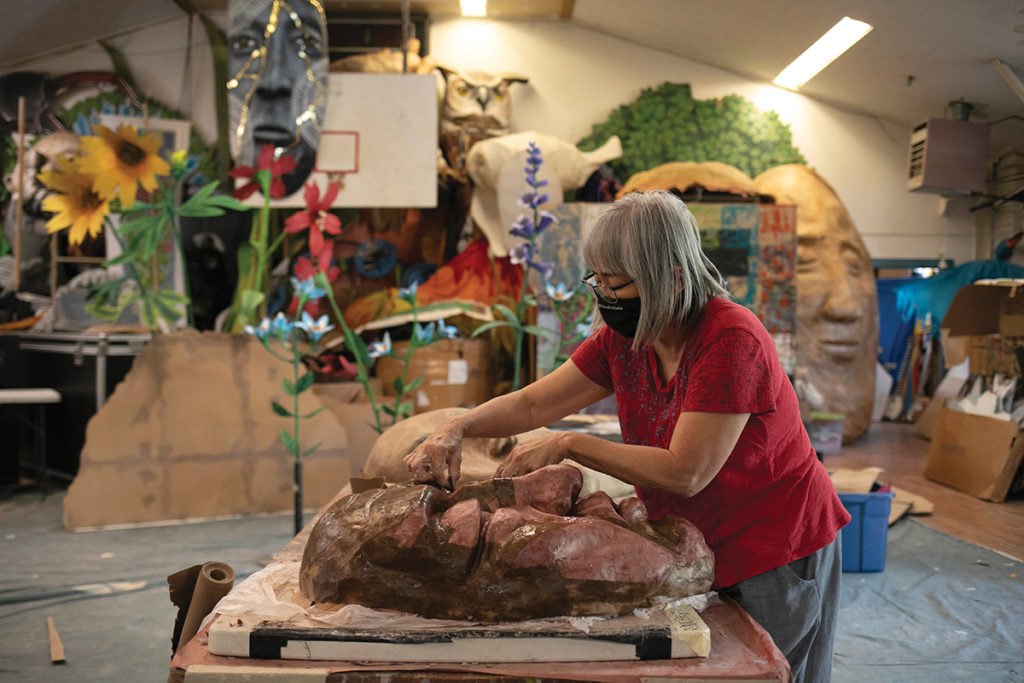
Donovan calls their team of artists, fabricators, interns, musicians and performers his “Paperhand Fam.” “We’re creating this culture of care, creativity and consent,” he says. “Creativity is at the core of it, but it’s also about creating care in how we speak to each other and how we make space for each other to shine.” Filmmaker Marc Levy followed Paperhand through the final stages of planning their 2019 show, We Are Here, and was struck by its sense of community. “Paperhand seems to function outside of the mainstream confines of the capitalistic system, and it’s also incredibly connected to its purpose of saving the world,” says Levy. “These people live according to their highest ideals.”
This year, Paperhand will explore the theme of time with The Meanwhile Clock: and Other Impossible Dances. The performance is based on Michael Ende’s 1973 fantasy novel MOMO, about an orphaned girl with an incredible gift for listening who is encouraged to be a compliant cog in the wheel of progress. Among the whimsical elements of the show, a specter of chaos and conflict looms.
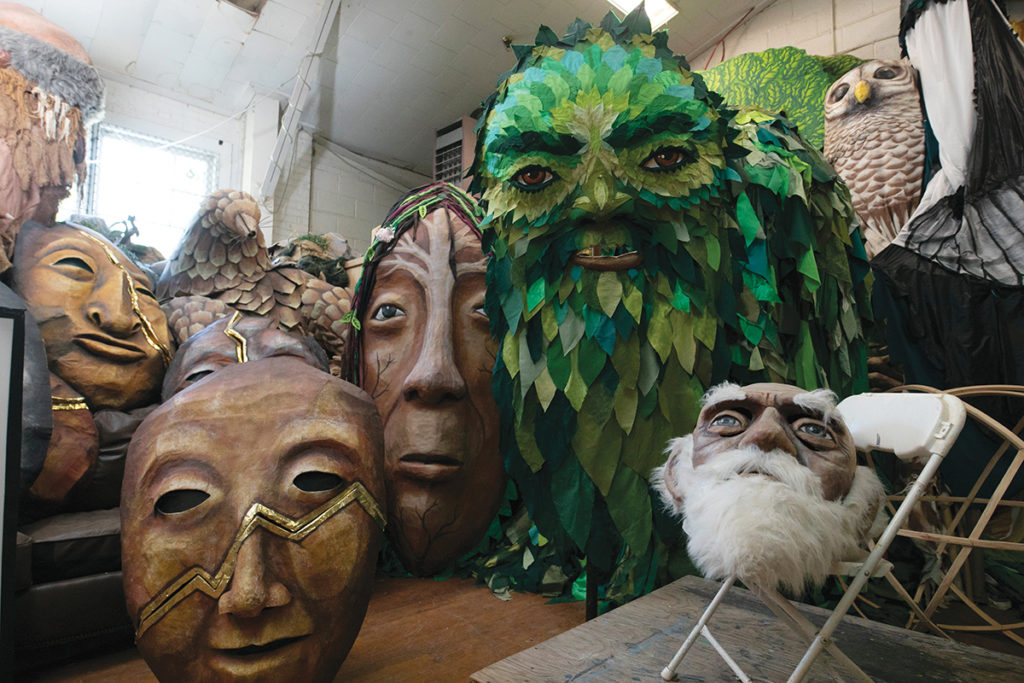
For Zimmerman and Burger, The Meanwhile Clock is a full-circle moment. “We got introduced to this story at the inception of Paperhand, when we first started doing the Haw River Learning Festival,” says Zimmerman, who notes that listening was an integral part of the festival’s team-building practice. “We would do check-ins where everyone would get a chance to speak from the heart and the others would listen actively without commenting.”
Through all of their performances, the Paperhand Puppet Intervention use the power of storytelling to get audiences thinking. “I don’t believe that Paperhand is in the position to give answers,” says Zimmerman, “but I believe very strongly in living into the questions and being present.”
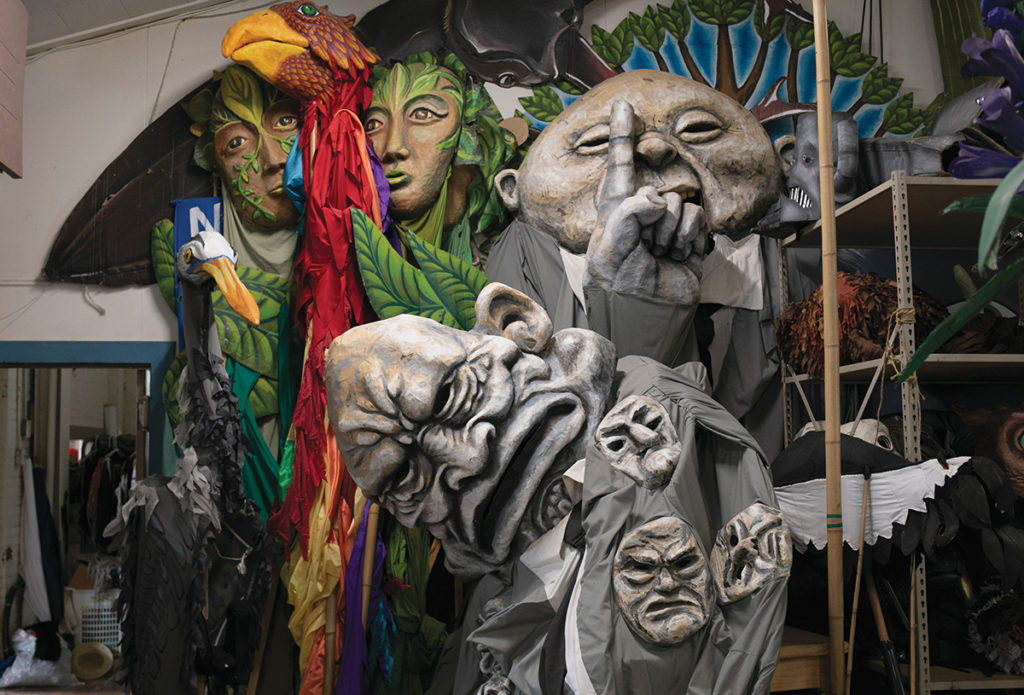
This article originally appeared in the August 2022 issue of WALTER Magazine.


